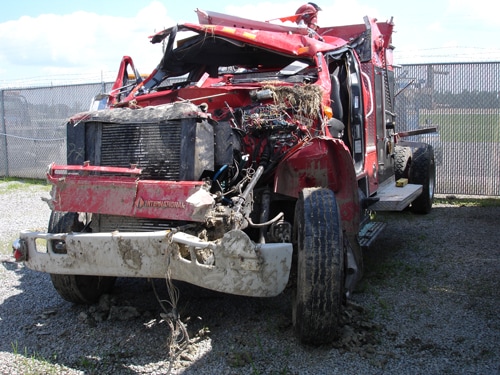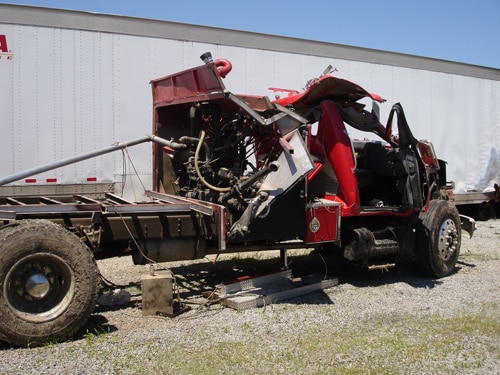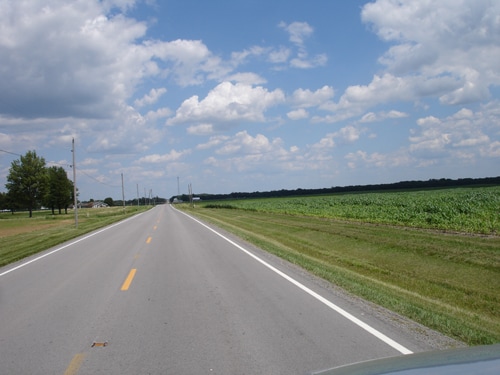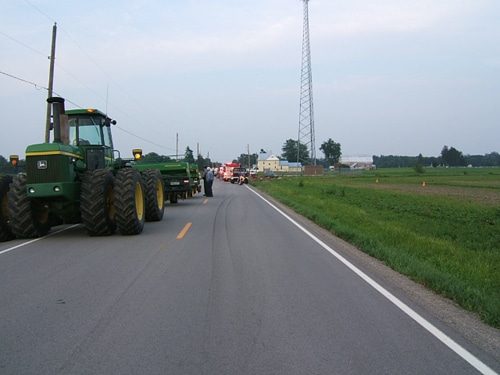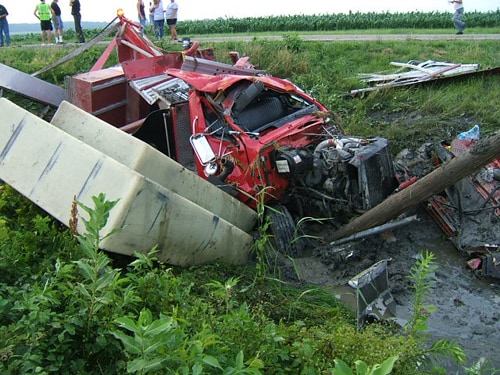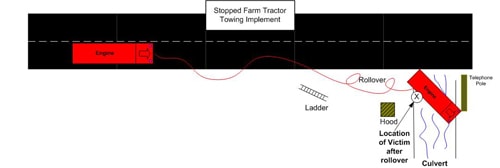Volunteer Fire Fighter Dies in Apparatus Crash - Ohio
 Death in the Line of Duty…A summary of a NIOSH fire fighter fatality investigation
Death in the Line of Duty…A summary of a NIOSH fire fighter fatality investigation
F2008-22 Date Released: September 21, 2009
SUMMARY
On July 7, 2008, a 58-year-old male volunteer fire fighter (the victim) was fatally injured after the engine he was driving left the roadway and overturned several times. The victim was en route to a vehicle fire and was approximately 1.4 miles from the fire station when the incident occurred. The engine left the roadway shoulder after misjudging the clearance to a large farm tractor stopped in the oncoming lane. The victim was not wearing a seat belt and was ejected from the vehicle. Another fire fighter onboard the apparatus crawled from the wreckage and began administering first aid to the seriously injured victim. The victim was airlifted to a medical center and was later pronounced dead. It was later determined that the victim was driving with a blood alcohol level in excess of the legal limit. Key contributing factors identified in this investigation include driving with a blood alcohol level in excess of the legal limit, not wearing seat belts, incorrectly judging the passing clearance when approaching a stopped vehicle, failure to keep the apparatus on the road surface, overcorrecting during the recovery maneuver, and limited experience with the incident apparatus.
The NIOSH investigator concluded that, in order to minimize the risk of similar occurrences, fire departments should:
- Enforce standard operating procedures on a “zero-tolerance policy” for alcohol use while engaged in any fire department activity.
- Enforce standard operating procedures that require mandatory use of seat belts in all vehicles.
- Consider additional driver training for fire fighters on safe driving and apparatus operations.
- Train apparatus driver/operators in regaining control when the right-side wheels leave the road surface.
INTRODUCTION
On July 7, 2008, a 58-year-old male volunteer fire fighter (the victim) was fatally injured after the engine he was driving left the roadway and overturned several times. On July 8, 2008, the U.S. Fire Administration (USFA) notified the National Institute for Occupational Safety and Health (NIOSH) of this incident. On July 14–18, 2008, a Safety and Occupational Health Specialist from the NIOSH Fire Fighter Fatality Investigation and Prevention Program traveled to Ohio to investigate this incident. The NIOSH investigator met with the chief of the victim’s fire department, other fire fighters who responded to the incident scene, the state highway patrol crash scene investigators, and the sheriff’s office personnel involved with the investigation. The investigator reviewed the victim’s driver/operator training records, inspected the incident apparatus, visited the incident site and took photographs and measurements. The investigator also reviewed the 911 dispatch logs, a recording of the fire fighter’s radio transmissions, the vehicle’s maintenance records, the state of Ohio traffic crash report, fire department/law enforcement photographs of the incident scene, and the coroner’s report.
FIRE DEPARTMENT
This volunteer fire department has 18 fire fighters who serve a population of approximately 1,650 within a rural area of approximately 51 square miles. The fire department is funded through the township and the fire fighters are considered paid-on-call. Eight of the fire fighters (not including the victim) have a commercial driver’s license. The department has an engine (the incident apparatus), a tanker, a grass truck, and a command vehicle. The department responds to approximately 35 incidents per year.
The fire department instituted a “zero-tolerance policy” for alcohol use in June 2007. The department’s rules and regulations state:
- “Under no circumstances shall any member drive and/or operate any fire department apparatus while under the influence of any alcohol and/or drugs that would impair the driver’s/operator’s ability to function appropriately.”
- “Under no circumstances shall any member arrive on an emergency or non-emergency scene involving and representing the fire department while under the influence of alcohol and/or drugs.”
- “Absolutely no alcoholic beverages shall be consumed DURING any fire department meeting involving the fire department or any county wide meetings hosted by the fire department.”
The fire department’s standard operating procedures on seat belts states “Seat belts–It is the State Law, Use THEM!!!!”
Every member of the department (including the victim) signed a statement stating that they had read and fully understood the rules and regulations set forth by the fire department.
TRAINING AND EXPERIENCE
The victim had 17 years experience as a volunteer with this fire department. The victim had received his state-required, 36-hour Fire Fighter 1A certification and routinely participated in monthly training topics presented through the department. Driver training was conducted through the Volunteer Firemen’s Insurance Services, Inc. The department also participates in joint training with mutual aid departments. The victim had a valid driver’s license with no previous vehicle crashes while driving emergency vehicles or personally owned vehicles.
Equipment
Engine 10 was a 1991 model engine which was purchased by the fire department in May 1991 (see Photos 1 and 2). The engine had a diesel engine, two axles, six tires, an automatic transmission and an air brake system. The engine had a gross vehicle weight rating (GVWR) of 44,000 lbs and it is believed that the engine was not over its GVWR at the time of the crash. The front axle was rated at 12,000 lbs; the rear axle was rated at 22,000 lbs. The engine measured 23.5 feet in length, 8.58 feet in height, and 8 feet in width with a wheelbase of 206 inches. The engine had a rectangular “T-shaped” 1,000 gallon plastic water tank which was baffled. The tank measured 10 feet in length, 2.92 feet in height, and 5.67 feet in width. The tank was filled to capacity at the time of the crash. The tires were in good condition and fully inflated. The engine was equipped with a bench seat with combination shoulder and lap seat belts. The engine contained a center dashboard radio mount which was within arm’s reach of the driver. The engine was equipped with an electric siren, air horn, and a red light bar mounted on the roof of the cab.
A review of the maintenance log indicated that only minor repairs had been performed. The water pump was replaced about 7 years previous to the incident. In 2005, the pump seals were replaced and the pump was tested by a fire apparatus servicing company. The vehicle’s mileage was 4,809.7 at the time of the incident. The vehicle was totaled as a result of the incident.
The state of Ohio does not require that fire apparatus receive an annual state inspection. The state of Ohio motor vehicle regulations do not require that emergency vehicle operators possess any special training or driver’s licenses such as a commercial driver’s license.
TIMELINE
Note: This timeline is provided to set out, to the extent possible, the sequence of events. Times are approximate and were obtained from review of the dispatch records, witness interviews, photographs of the scene and other available information. In some cases the times may be rounded to the nearest minute, and some events may not have been included. The timeline is not intended, nor should it be used, as a formal record of events.
Key events included:
- 1957 Hours
911 received a call reporting a vehicle fire - 1958 Hours
911 dispatched fire department - 2001 Hours
911 dispatch reports “truck on fire in driveway extending to building” - 2002 Hours
Engine 10 (incident apparatus) en route with 2 fire fighters (victim and injured fire fighter) - 2005 Hours
Tanker 10 en route with 2 fire fighters
Grass Truck 10 en route with 3 fire fighters
Additional fire fighters responding in privately owned vehicles - 2007 Hours
Engine 10 approaches stopped farm tractor, misjudges clearance, runs off road, and crashes - 2008 Hours
Tanker 10 radios dispatch reporting “rolled over fire truck” - 2011 Hours
Tanker 10 radios dispatch and requests a life flight helicopter
ROAD AND WEATHER CONDITIONS
The incident occurred on a rural county road (see Photo 3) approximately 1.4 miles from the fire station. The road was asphalt and 24 feet wide. The asphalt road faded without a shoulder into loose gravel leading into a ditch. The road had a posted speed limit of 55 mph and according to crash investigators speed was not a factor in this incident. On the day of the incident, the road was dry and the weather was clear at 81°F. Within the last 10 years, the loose shoulder and drop-off have contributed to two previous commercial vehicle crashes within 0.5 mile of the incident site, according to the fire department and law enforcement.
INVESTIGATION
On July 7, 2008 at 1957 hours, 911 dispatch received a cellular call reporting a vehicle on fire parked beside a residential structure. At 1958 hours, 911 dispatch paged the victim’s department reporting the fire. Dispatch made a second page at 2001 hours reporting a “truck on fire with extension to building.” The department responded with Engine 10, Tanker 10, and Grass Truck 10. The victim arrived at the fire station from home and got in the driver’s seat of Engine 10. When another volunteer fire fighter got in the passenger’s seat the victim pulled out of the station and proceeded to the fire scene. (Note: Neither fire fighter was wearing a seat belt). At 2002 hours, the fire fighter (passenger) radioed dispatch that they were en route and requested two additional mutual aid departments to respond. At 2005 hours, Tanker 10 was en route to the fire following behind Engine 10.
At 2007 hours, the victim approached a farm tractor traveling in the oncoming direction that had stopped to allow the engine to pass. The tractor was towing a farm implement (grain drills) and had pulled over as far as possible (see Photo 4), but the implement was closer to the center line than the tractor. (Note: The driver of the tractor was returning home from a field he had sowed. The tractor was being operated in accordance with all state laws). The victim misjudged the clearance distance and the engine’s right front tire went off the road into loose gravel which graded down into a ditch. The right rear tire caught the gravel and the victim pulled the steering wheel hard to the left. The victim was able to get all four wheels back on the asphalt but then steered hard to the right to avoid hitting the tractor. The victim then drove off the right side of the road, and, as the victim tried to steer back onto the road, the engine began to roll. The engine rolled down into a culvert, struck a telephone pole and landed upright (see Photo 5 and Diagram). The apparatus rolled at least twice, and the victim was ejected through the windshield, landing about 10 feet away. The injured fire fighter crawled from the wreckage and began first aid on the victim until other fire fighters arrived.
Fire fighters following behind in Tanker 10 witnessed the incident, and at 2008 hours radioed dispatch that a fire truck had rolled over. At 2011 hours, a life flight helicopter was requested. The helicopter arrived on scene at 2039 hours and transported the victim to a metropolitan trauma center where he was later pronounced dead. It was later determined that the victim was driving with a blood alcohol level in excess of the legal limit of 0.08%. The injured fire fighter was treated and released from the emergency room of the local hospital. He sustained lacerations to the front and back of his head, abrasions to the right side of his body, and contusions to his back. (Note: The two mutual aid companies responded to and extinguished the vehicle fire).
CONTRIBUTING FACTORS
Occupational injuries and fatalities are often the result of one or more contributing factors or key events in a larger sequence of events that ultimately result in the injury or fatality. The NIOSH investigator identified the following items as key contributing factors in this incident that ultimately led to the fatality:
- Driving with a blood alcohol level in excess of the legal limit.
- Not wearing seat belts.
- Incorrectly judging the passing clearance when approaching the stopped farm tractor.
- Failure to keep the apparatus on the road surface.
- Overcorrecting during the recovery maneuver.
- Limited experience with the incident apparatus.
CAUSE OF DEATH
According to the county coroner, the cause of death was accidental with multiple blunt force injuries. At the time of autopsy, the victim had a blood alcohol level in excess of the legal limit of 0.08%.
RECOMMENDATIONS/DISCUSSIONS
Recommendation #1: Fire departments should enforce standard operating procedures on a “zero-tolerance policy” for alcohol use while engaged in any fire department activity.
Discussion: The National Fire Protection Association (NFPA)1 and the International Association of Fire Chiefs (IAFC)2 have developed guidance on implementing a “zero-tolerance alcohol” policy. NFPA 1500 Standard on Fire Department Occupational Safety and Health Program states in 10.1.5 “Members who are under the influence of alcohol or drugs shall not participate in any fire department operations or other duties.” The IAFC has issued a policy statement for alcohol and drinking in the fire service that states:
- Basically, if someone has consumed alcohol within the previous eight (8) hours, or is still noticeably impaired by alcohol consumed previous to the eight (8) hours, they must voluntarily remove themselves from the activities and functions of the fire or emergency services agency/organization, including all emergency operations and training.
- No member of a fire and emergency services agency/organization shall participate in any aspect of the organization and operation of the fire or emergency agency/organization under the influence of alcohol, including but not limited to any fire and emergency operations, fire-police, training, etc.
- No alcohol shall be on the premises of any operational portion of the fire department, including but not limited to the apparatus, the apparatus floor, the station living areas, etc.
- Fire and emergency services agencies/organizations which raise funds by operating and/or renting social halls must provide a clear and distinct separation of facilities to help insure the zero-tolerance standard of alcohol consumption by their members who may be called upon to perform official duties.
- All fire and emergency service agencies/organizations should develop written policies and have procedures in place to support and enforce this policy recommendation. Included in such a policy should be provisions for blood alcohol testing of any individuals involved with any accident that causes measurable damage to apparatus or property or injury/death of agency/organization personnel or civilians.2
Consumption of alcohol has immediate depressant effects on the human brain. These depressant effects impact the performance of various tasks including the ability to drive an automobile. Specifically, alcohol impairs behaviors critical to driving such as cognitive functioning, sensorimotor coordination, increased drowsiness, reduced vigilance, and divided attention. In addition, alcohol has been shown to impair actual driving performance skills such as maintaining lateral position on a simulated road, and increased reaction time.3
Recommendation #2: Fire departments should enforce standard operating procedures that require mandatory use of seat belts in all vehicles.
Discussion: Numerous nationally recognized fire service organizations have guidance available on implementing a seat belt policy. Fire departments should develop, implement and enforce standard operating procedures (SOPs) on the use of seat belts in accordance with NFPA guidelines. NFPA 1500 Standard on Fire Department Occupational Safety and Health Program states that all persons riding in fire apparatus shall be seated and belted securely by seat belts in approved riding positions at any time the vehicle is in motion. The standard further states that seat belts shall not be released or loosened for any purpose while the vehicle is in motion.1 NFPA 1901 Standard for Automotive Fire Apparatus, establishes requirements for the minimum length of seat belts, together with how they are measured. The standard also recommends that a seat belt warning device be installed to indicate when seat belts are not being properly used.4 The IAFC position on seat belt usage states “All personnel must be seated and belted whenever the vehicle (either department or personal) is in motion for department business. The driver and/or officer shall assure by voice and personal reply that seat belts are properly fastened. The driver will only proceed when it can be confirmed that all members are seated and belted.”5 The International Association of Fire Fighters (IAFF) provides guidance on seat belt usage in Fire Department Vehicle Safety, Emergency and Non-Emergency Response, and Safe Emergency Operations on Roadways. It states “All employees are required to use seat belts at all times when operating a fire department vehicle. All personnel shall ride only in regular seats provided with seat belts. The company officer and driver of the vehicle shall confirm that all personnel and riders are on-board, properly attired, with seat belts on, before the vehicle is permitted to move. This confirmation shall require a positive response from each rider.”6
For guidance, increased awareness, and a show of commitment to the enforcement of seat belt usage, fire departments should consider recommending that members participate in the National Seat Belt Pledge Campaign.7 NIOSH, USFA, NFPA, IAFC, the National Volunteer Fire Council, and the National Fallen Fire Fighters Foundation all support the campaign as a method of raising awareness of the importance of mandatory use of seat belts by all fire fighters.8 Fire fighters wearing seat belts are an essential component of efforts to ensure the safety of fire fighters in fire apparatus and vehicles. Fire fighters who take the pledge and fire departments who achieve 100% pledge participation show their individual and organizational commitment to fire fighter safety.
According to the traffic crash report, neither the victim nor the injured fire fighter was wearing a seat belt. The victim was ejected during the rollover and was fatally injured. If the victim had been wearing a seat belt, it is possible that he would not have been ejected from the apparatus and that his injuries may not have been fatal.
Recommendation #3: Fire departments should consider additional driver training for fire fighters on safe apparatus driving and apparatus operations.
Discussion: Fire departments should provide adequate resources and training to ensure that the safe arrival (and return from) an emergency scene is their first priority. Fire departments should develop, implement, and enforce written standard operating procedures and ensure fire fighters are thoroughly trained and qualified prior to driving and operating emergency vehicles. The minimum requirements for a fire service vehicle operations training program are contained in NFPA 1451 Standard for a Fire Service Vehicle Operations Training Program.9 The objective of the training program is to prevent crashes, injuries and fatalities (both civilian and fire service) involving fire service vehicles. An emergency vehicle operator course including a defensive driving segment and practical exercises, should be completed at least every three years. Fire departments should also consider whether a commercial driver’s license is appropriate based on vehicle characteristics and state requirements. Driver training should be conducted in accordance with NFPA 1451 Standard for a Fire Service Vehicle Operations Training Program and NFPA 1002 Fire Apparatus Driver/Operator Professional Qualifications.9, 10 These standards state that departments should establish and maintain a driver training education program and each member should be provided driver training not less than twice a year. During this training, each driver should operate the vehicle and perform tasks that the driver/operator is expected to encounter during normal operations to ensure the vehicle is safely operated in compliance with all applicable state and local laws.
The apparatus involved in this incident was 17 years old and had 4809.7 miles on the odometer at the time of the crash. This means that on average, the apparatus was operated for 283 miles per year or 24 miles per month. Thus, the limited operational experience with the incident apparatus by the victim may have contributed to the crash.
Recommendation #4: Fire departments should train apparatus driver/operators in regaining control when the right-side wheels leave the road surface.
Discussion: A significant number of fire department apparatus crashes have occurred as a result of the apparatus drifting off the right side of the road surface.11 This situation develops when, for whatever reason, the apparatus drifts too far to the right and the front, rear, or both sets of tires leave the paved surface. Generally, the simple act of the tires leaving the paved surface does not create a significant hazard in and of itself. It is possible that, if the shoulder is very soft, it could throw the vehicle toward the right into an object along the roadway or perhaps into a rollover situation. However, most crashes that occur when the right side wheels leave the paved surface are as a result of an “overcorrection” by the driver when attempting to bring the right side wheel(s) back onto the paved surface. Often, there will be a lip of 4 to 8 inches where the paving drops off onto the soft shoulder. When the driver attempts to bring the right-side tires over this lip back onto the paved surface at too high of a speed, the common reaction is for the vehicle to shoot quickly toward the left. This could cause the apparatus to enter opposing lanes of traffic, go completely off the left side of the road, or to begin a rocking motion that results in loss of control of the vehicle. In other cases, the vehicle may stay on the roadway, but the jerking action of jumping back onto the paved surface causes the rear end of the vehicle to swing out in a counterclockwise motion, causing the vehicle to overturn.
Drivers must be trained regarding the hazards of drifting off the right side of the paved surface. When either or both of the right-side wheels/tires drift off of the paved surface, the driver should be instructed to slow the vehicle gradually to a safe speed before attempting to bring the wheel back onto the paved surface. There is no defined speed at which this is always safe as it will depend on many factors, including the size of the lip, the characteristics of the vehicle, and driver skill. 11
REFERENCES
- NFPA [2007]. NFPA 1500 Standard on fire department occupational safety and health program. 2007 ed. Quincy, MA: National Fire Protection Association.
- IAFC [2003]. Policy statement: zero-tolerance for alcohol and drinking in the fire and emergency servicepdf iconexternal icon. Fairfax, VA: International Association of Fire Chiefs. [http://www.iafc.org/associations/4685/files/downloads/ABOUT/POLICY_STATES/IAFCpol_Alcohol_inFireEmergServ.pdf]. Date accessed: September 2009.
- Jones RK, Lacey JH [2001]. Alcohol and Highway Safety 2001: A Review of the State of Knowledgeexternal icon. Washington D.C.: U.S. Department of Transportation, National Highway Traffic Safety Administration, Office of Research and Traffic Records, Publication No. DOT HS 809 383. [http://www.nhtsa.gov/people/injury/research/AlcoholHighway/index.htm#Contents]. Date accessed: September 2009. (Link Updated 1/17/2013)
- NFPA [2009]. NFPA 1901 Standard for automotive fire apparatus. 2009 ed. Quincy, MA: National Fire Protection Association.
- IAFC [2008]. Position statement: seat belt usagepdf iconexternal icon. Fairfax, VA: International Association of Fire Chiefs. [http://www.iafc.org/files/1ASSOC/IAFCposition_SeatbeltUsage.pdf (Link Updated 5/13/2015)]. Date accessed: September 2009.
- IAFF [2006]. Fire department standard operating procedure, fire department vehicle safety, emergency and non-emergency response, safety emergency operations on roadwayspdf iconexternal icon. Washington DC: International Association of Fire Fighters. [http://iaff.org/hs/evsp/Vehicle%20Safety%20SOP.pdf]. Date accessed: September 2009. (Link Updated 1/17/2013)
- USFA/FEMA [2009]. National fire service and EMS seat belt pledge. Emmitsburg, MD: U.S. Fire Administration. [http://www.trainingdivision.com/seatbeltpledge.asp]. Date accessed: September 2009. (Link no longer available 1/15/2013)
- USFA/FEMA [2009]. Press release NIOSH supports seat belt use by fire fightersexternal icon. Emmitsburg, MD: U.S. Fire Administration. [http://www.usfa.fema.gov/media/press/2008releases/111808.shtm]. Date accessed: September 2009. (Link Updated 1/17/2013)
- NFPA [2007]. NFPA 1451 Standard for a fire service vehicle operations training program. 2007 ed. Quincy, MA: National Fire Protection Association.
- NFPA [2009]. NFPA 1002 Standard on fire apparatus driver/operator professional qualifications. 2009 ed. Quincy, MA: National Fire Protection Association.
- USFA/FEMA [2003]. Safe operation of fire tankerspdf iconexternal icon. Emmitsburg, MD: U.S. Fire Administration, Publication No. FA 248. [http://www.usfa.fema.gov/downloads/pdf/publications/fa-248.pdf]. Date accessed: September 2009. (Link Updated 1/17/2013)
INVESTIGATOR INFORMATION
This incident was investigated by CDR Steve Berardinelli, Safety and Occupational Health Specialist with the Fire Fighter Fatality Investigation and Prevention Program, Surveillance and Field Investigations Branch, Division of Safety Research, NIOSH located in Morgantown, WV. A technical review was provided by Deputy Chief John Tippett, city of Charleston Fire Department, Charleston, SC. Chief Tippett assisted in the development of the IAFC’s National Fire Fighter Near-Miss Reporting Systemexternal icon (www.FirefighterNearMiss.com).
|
The National Institute for Occupational Safety and Health (NIOSH), an institute within the Centers for Disease Control and Prevention (CDC), is the federal agency responsible for conducting research and making recommendations for the prevention of work-related injury and illness. In fiscal year 1998, the Congress appropriated funds to NIOSH to conduct a fire fighter initiative. NIOSH initiated the Fire Fighter Fatality Investigation and Prevention Program to examine deaths of fire fighters in the line of duty so that fire departments, fire fighters, fire service organizations, safety experts and researchers could learn from these incidents. The primary goal of these investigations is for NIOSH to make recommendations to prevent similar occurrences. These NIOSH investigations are intended to reduce or prevent future fire fighter deaths and are completely separate from the rulemaking, enforcement and inspection activities of any other federal or state agency. Under its program, NIOSH investigators interview persons with knowledge of the incident and review available records to develop a description of the conditions and circumstances leading to the deaths in order to provide a context for the agency’s recommendations. The NIOSH summary of these conditions and circumstances in its reports is not intended as a legal statement of facts. This summary, as well as the conclusions and recommendations made by NIOSH, should not be used for the purpose of litigation or the adjudication of any claim. For further information, visit the program website at www.cdc.gov/niosh/fire or call toll free 1-800-CDC-INFO (1-800-232-4636).
|
This page was last updated on 10/29/09.

